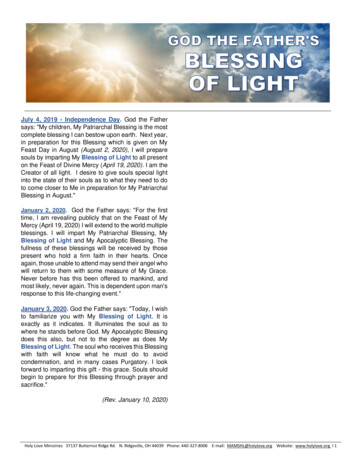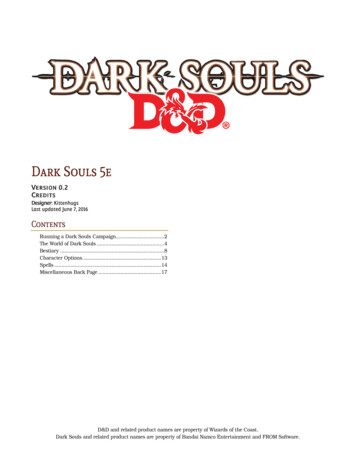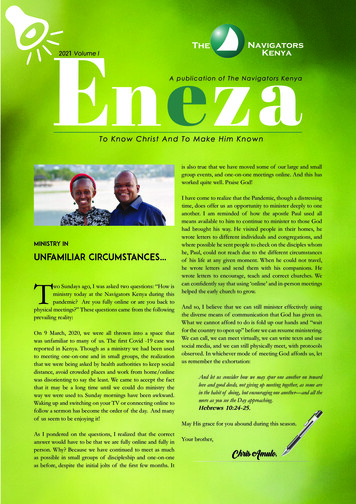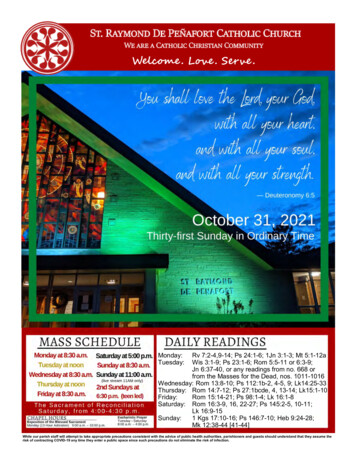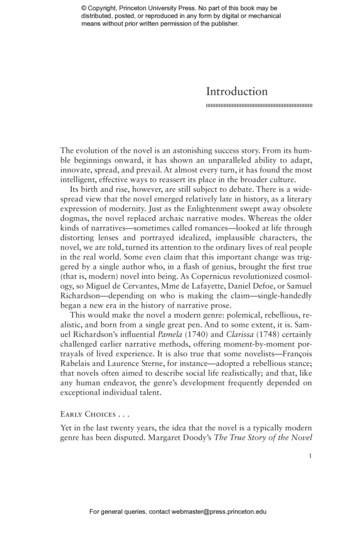
Transcription
Copyright, Princeton University Press. No part of this book may bedistributed, posted, or reproduced in any form by digital or mechanicalmeans without prior written permission of the publisher.IntroductionThe evolution of the novel is an astonishing success story. From its humble beginnings onward, it has shown an unparalleled ability to adapt,innovate, spread, and prevail. At almost every turn, it has found the mostintelligent, effective ways to reassert its place in the broader culture.Its birth and rise, however, are still subject to debate. There is a widespread view that the novel emerged relatively late in history, as a literaryexpression of modernity. Just as the Enlightenment swept away obsoletedogmas, the novel replaced archaic narrative modes. Whereas the olderkinds of narratives— sometimes called romances— looked at life throughdistorting lenses and portrayed idealized, implausible characters, thenovel, we are told, turned its attention to the ordinary lives of real peoplein the real world. Some even claim that this important change was triggered by a single author who, in a flash of genius, brought the first true(that is, modern) novel into being. As Copernicus revolutionized cosmology, so Miguel de Cervantes, Mme de Lafayette, Daniel Defoe, or SamuelRichardson— depending on who is making the claim— single- handedlybegan a new era in the history of narrative prose.This would make the novel a modern genre: polemical, rebellious, realistic, and born from a single great pen. And to some extent, it is. Samuel Richardson’s influential Pamela (1740) and Clarissa (1748) certainlychallenged earlier narrative methods, offering moment- by- moment portrayals of lived experience. It is also true that some novelists— FrançoisRabelais and Laurence Sterne, for instance— adopted a rebellious stance;that novels often aimed to describe social life realistically; and that, likeany human endeavor, the genre’s development frequently depended onexceptional individual talent.Early Choices . . .Yet in the last twenty years, the idea that the novel is a typically moderngenre has been disputed. Margaret Doody’s The True Story of the Novel1For general queries, contact webmaster@press.princeton.edu
Copyright, Princeton University Press. No part of this book may bedistributed, posted, or reproduced in any form by digital or mechanicalmeans without prior written permission of the publisher.2i n t ro duc t i o n(1996) and Didier Souiller and Wladimir Troubetzkoy’s chapter on thenovel in their Littérature comparée (1997) showed that long prose narratives, far from being a recent European invention, have much deeperroots. Franco Moretti’s comprehensive collection Il Romanzo (2001)and its partial English translation The Novel (2006– 2007) demonstratedthat the rise of the novel from the Renaissance to the nineteenth centurywas not so much the invention of a genre as a European acceleration ofits growth, which then prompted a global expansion. Indeed, if we takeearly Japanese and Chinese fiction into consideration— The Tale of Genjiby Murasaki Shikibu (eleventh century), Water Margin (fourteenth century), Romance of the Three Kingdoms by Luo Guanzhong (fourteenthcentury), Journey to the West by Wu Cheng’en (sixteenth century), andThe Story of the Stone by Cao Xueqin (eighteenth century)— it becomesclear that the genre’s roots are not confined to a single geographic space.Steven Moore’s The Novel: An Alternative History. Beginnings to 1600examines the worldwide wealth of narratives that, from ancient Egypt toancient China and Japan, made the rise of the novel possible.Agreeing with this approach, the present book aims to show that the“European acceleration” of the novel (to use Franco Moretti’s phrase)began as a long- term rivalry between various kinds— various subgenres— of prose narrative. Just as in present- day bookstores customerswalk between shelves marked “literature,” “Westerns,” “mystery novels,”or “science fiction,” sixteenth- and seventeenth- century readers were usedto distinguishing between ancient Greek novels, late medieval chivalricstories, pastorals, picaresque stories, and novellas. Each kind of storyportrayed a different aspect of the human condition— heroically chastelove in the ancient Greek novel, individual valor in chivalric tales, gentlesentiments in the pastoral, deceit in the picaresque, and sudden, surprising action in novellas. Each type handled form and content in its ownway. Most importantly, these subgenres formed two large groups, one ofwhich promoted a celebratory, idealist view of human life and behavior,while the other developed a derogatory, anti- idealist attitude. Idealist narratives, such as the ancient Greek and chivalric novels, featured upliftingcharacters and deeds, while the anti- idealist ones, like picaresque stories and many novellas, deplored or satirized unusually bad people andactions.In the eyes of the late sixteenth- century public, the most successfulcelebratory, idealist novels had been written long before, between the firstand the fourth centuries, by Greek colonists established on the easternshores of the Mediterranean. In the Ethiopian Story by Heliodorus, rediscovered at the end of the fifteenth century and translated into French,Italian, Spanish, English, and German, the two young protagonists, Chariclea and Theagenes, fall in love at Apollo’s shrine at Delphi. After takingFor general queries, contact webmaster@press.princeton.edu
Copyright, Princeton University Press. No part of this book may bedistributed, posted, or reproduced in any form by digital or mechanicalmeans without prior written permission of the publisher.INTRODUCTIO N3a pledge of chastity, they flee Greece and go through a multitude of ordeals, including shipwrecks, kidnapping by bandits, separation, and thelustful advances of unscrupulous rulers. Eventually, they reach the sacredrealm of Ethiopia, where Chariclea turns out to be none other than thelong- lost daughter of the Ethiopian king.Ancient Greek novels, little read or discussed in late antiquity, wereremembered and imitated in the Byzantine Empire, but not in medievalwestern Europe, where the public favored a different kind of idealist narrative, the chivalric stories in which brave knights and proud ladies struggle to keep their love alive in adversity. Unlike the perfect protagonists ofancient Greek novels, medieval characters can be absentminded or havetrouble mastering their urges. They might forget their pledges, and theirlove— Tristan and Isolde’s, for example, or Lancelot and Guinevere’s— issometimes adulterous. Still, provided the knight fights valiantly, his unreliability, carelessness, and even adultery may be forgiven in the end.Steeped in archaic, pagan beliefs (from paganus: “villager”), chivalricstories remain very close to old legends, sagas, and fairy tales, and, likethem, are full of sorcerers, prophets, talking animals, charmed objects,and enchanted cities.Renaissance writers, who worshipped antiquity and in principlelooked down on medieval art and literature, were nonetheless partial tosuch flights of fancy. Fifteenth- and sixteenth- century Italian poets reworked chivalric stories into a new genre, the “fantasy epic.” Luigi Pulci’sMorgante (1483), Matteo Maria Boiardo’s Orlando Innamorato (1495),and Ludovico Ariosto’s Orlando Furioso (1532) are about the intricateadventures of medieval knights frolicking in a fairy- tale environment thatis never supposed to seem fully real or plausible. At the same time, latechivalric narratives in prose continued to flourish as a distinct group ofidealist, celebratory stories, the most successful being Amadis of Gaul(published in 1508, but written earlier), the tale of a perfect knight whoselove, eloquence, and heroic feats stirred the imaginations of Europeanreaders until late in the eighteenth century.In search of the best possible idealist narratives, late sixteenth- centurywriters felt they must choose between late chivalric stories in prose andthe newly rediscovered ancient Greek novels, between Amadis of Gauland the Ethiopian Story. Discerning people saw the latter as the truemodel of the genre. Cervantes, for one, agreed and emulated it in his lastwork, Persiles and Sigismunda (1617), which he considered his greatestliterary achievement. He was not the only writer to take this path: imitations of the ancient Greek novel thrived in much of Europe from theend of the sixteenth through the first half of the seventeenth century, andwere read fervently until the end of the eighteenth. Among them wereMary Wroth’s Urania (1621), Gomberville’s Polexandre (1632– 1637),For general queries, contact webmaster@press.princeton.edu
Copyright, Princeton University Press. No part of this book may bedistributed, posted, or reproduced in any form by digital or mechanicalmeans without prior written permission of the publisher.4i n t ro duc t i o nArtamène ou le Grand Cyrus (1649– 1653) by Madeleine de Scudéry,Aramena (1669– 1673) by Anton Ulrich, and Oroonoko (1688) by AphraBehn.Equally important for the sixteenth- century public was another, morerecent species of idealist narrative: the pastoral novels that flourished inItaly and Spain and later conquered England and France. The first Spanish pastoral, Jorge de Montemayor’s Diana (1559), was very popular inthe late sixteenth century, and was one of Shakespeare’s sources. In theearly 1580s, Sir Philip Sidney finished his Old Arcadia, though it wasnot published until much later. And at the beginning of the seventeenthcentury, Honoré d’Urfé’s five- volume Astrea (1607– 1627) became thelongest, most complex specimen of the pastoral.Ancient Greek novels, medieval chivalric stories, and pastorals alltransported their readers into a realm quite different from everyday reality, and consequently required a drastic suspension of disbelief. NicolasBoileau, a seventeenth- century French critic, marveled to see the beautifulyoung heroine of Madeleine de Scudéry’s long- winded Artamène fall overand over again into the hands of evil brigands, and yet always manage tokeep her chastity intact. Similar objections had been raised against Amadis of Gaul and the Diana. They didn’t matter, though, since these novelswere meant to offer a lofty, implausible view of the world.Later writers and critics would assume that these inspiring but unbelievable narratives had been rendered obsolete in the eighteenth centuryby modern, realist novels. Early modern writers and readers knew better.Idealist, celebratory novels had never been the only fictional diet. The oldest satiric narratives— Petronius’s Satyricon (first century) and the medieval Roman de Renart (twelfth century)— were not widely available, butthere were other anti- idealist comic fictions to satisfy the public appetitefor satire. Many of the Italian Renaissance novellas of Giovanni Boccaccio and Matteo Bandello were particularly sharp on human imperfection,while the then recent Spanish picaresque stories, Lazarillo de Tormes(1554, anonymous) and Quevedo’s El Buscón (1626), described thievesand vagabonds devoid of any scruples or decency. Several of Cervantes’snovellas and comic theatrical interludes, as well as the main character ofDon Quixote (1605, 1615), are indebted to these “derogatory” narratives. The public also loved poignant anti- idealist stories, which presentedhuman failings in a compassionate rather than sarcastic mode: tragic Italian novellas by Boccaccio, Bandello, and Cinzio, and Spanish novellas byCervantes and María de Zayas all bemoaned people’s inability to mastertheir passions.Another significant difference between early modern prose subgenreswas that some portrayed the “world at large,” while others aimed straightat the “heart of the matter.” A good novel was not only expected to beFor general queries, contact webmaster@press.princeton.edu
Copyright, Princeton University Press. No part of this book may bedistributed, posted, or reproduced in any form by digital or mechanicalmeans without prior written permission of the publisher.INTRODUCTIO N5faithful to the type it exemplified, whether celebratory (Heliodoran, chivalric, or pastoral) or derogatory (comic or picaresque), but it also had tolink together a large number of episodes, all with similar causes and outcomes: thus the worldview it offered was both ample, since the characterswere taken on a long ride, and somewhat monotonous, since they alwaysencountered the same kinds of obstacles and had the same kinds of adventures. Ancient Greek novels and their imitations worked this way, asdid comic and picaresque stories. Novellas, however, whether serious,tragic, or comic, cut down the number of episodes and went straight tothe heart of the conflict. Since unity of action was the novella’s strongpoint, they were often adapted by playwrights— Shakespeare used storiesby Bandello and Cinzio for Romeo and Juliet and Othello.Finally, although prose narratives were expected to show clearlywhether they belonged to the idealist or the anti- idealist subgenre, a certain amount of variety was always welcome. Authors of Heliodorus- likenovels never forgot to include some episodes about despicable characters,while those writing picaresque novels learned to embed loftier stories inthem. As for the shorter, more focused novella, Boccaccio, Marguerite deNavarre, Bandello, and Cervantes published theirs in large collections,with comic and tragic stories side by side. In a culture that favored easilyidentifiable narrative species, these amalgamations provided a balance. . . And What Happened LaterWhile the early period should not be seen as mere preparation for a genuine rise of the novel in the eighteenth century, its achievements did playa major role in the subsequent history of the genre. Samuel Richardson,a self- taught writer, realized that the best features of the older narrative subgenres could be mixed together. The sublime heroes and multipleadventures of the ancient Greek novel, the humble social origins of picaresque characters, and the dramatic events of the novella could all becombined into a single narrative— as inspiring as an old romance, as closeto everyday life as a comic story, and as striking as a novella. In Richardson’s Pamela, the main character is a young woman whose virtue andresistance in the face of danger seem to come straight out of an ancientGreek novel. Yet she leads a modest, plausible life in provincial England.What’s more, her heart- wrenching situation, as a servant pursued by anundeserving master, would fit well in a Renaissance novella. By minglingthese features, Richardson could uplift his readers without carrying themoff into a fully implausible realm, he could tell a story as compelling as anovella and as extended as a picaresque novel, and, most importantly forhis time, he could show the moral equality of people regardless of theirsocial position.For general queries, contact webmaster@press.princeton.edu
Copyright, Princeton University Press. No part of this book may bedistributed, posted, or reproduced in any form by digital or mechanicalmeans without prior written permission of the publisher.6i n t ro duc t i o nRichardson’s new, more plausible idealism was an immediate and lasting success. His Pamela and Clarissa became required reading for novelists well into the nineteenth century. Yet his innovations did not remainunchallenged. Significantly, his best- known competitor, Henry Fielding,defended the older anti- idealist approach, particularly its comic version.Joseph Andrews (1742) and Tom Jones (1749) reject the representationof idealized behavior in favor of satire. Richardson and Fielding eachthought only one kind of novel— his kind— should prevail. Under theinfluence of Richardson’s moderate idealism and Fielding’s ironic skepticism, people began to understand the novel as a long prose narrativewhose well- constructed plot stays close to everyday life and whose characters have both virtues and faults.Two generations later, Walter Scott, followed by Honoré de Balzac, assigned the novel a new task: it should represent not only moral physiognomies but also the historical and social texture of the characters’ world.In the 1842 foreword to his Human Comedy, a vast fictional panoramaof early nineteenth- century French society, Balzac asked writers to emulate natural science by studying each social species and its behavior. Heexpected the novel to become the most reliable instrument for understanding society and the individual’s place in it. Balzac’s manifesto wasnot just a symptom of the genre’s new self- assurance; it also formulated aconqueror’s project. Whereas early modern narrative subgenres had eachaddressed a specific facet of life, the nineteenth- century social and historical novel aspired to provide full, systematic coverage of humankind. Notunlike Napoleon Bonaparte, whose explicit aim was to conquer Europeand make Paris its capital, Balzac hoped to establish a new empire ofliterature, with the novel at its center.And just as Europe did move toward unification, though much laterand quite differently from the way Napoleon had planned it, so the novelgradually became the most influential literary genre, though not exactlyalong the lines envisaged by Balzac. With all its success, the social andhistorical novel had plenty of rivals and detractors. Gothic novelists,who had been around for a while, idealists such as Alessandro Manzoniand Victor Hugo, painters of intimacy such as Jane Austen and AdalbertStifter, skeptics like Stendhal and, later, Gustave Flaubert, and satiristslike William Makepeace Thackeray all challenged the imperial designs ofsocial realism. At the same time, the great novels of George Eliot, FyodorDostoevsky, Leo Tolstoy, Theodor Fontane, Benito Pérez Galdós, andJosé Maria de Eça de Queirós imagined a variety of syntheses betweenthe admirable and pitiful aspects of the human condition.In an equally important development, the Romantics deemed the social novel unduly prosaic, unable to transport its readers beyond the borders of everyday reality. Some of the most important nineteenth- centuryFor general queries, contact webmaster@press.princeton.edu
Copyright, Princeton University Press. No part of this book may bedistributed, posted, or reproduced in any form by digital or mechanicalmeans without prior written permission of the publisher.INTRODUCTIO N7philosophers, including Hegel, Schelling, and Schopenhauer, also felt thatdespite its success with the reading public, the novel was a pedestrianand uninspiring genre. Something was missing, something that— unlikehistorical and social realism— poetry, music, and some older narrativesknew how to convey.In answer to this challenge, the novel started a new adventure. At theend of the nineteenth and the beginning of the twentieth century, thegrowing cult of artistic beauty encouraged writers to infuse their prosewith a new poetic fervor. Hoping to induce a special rapture in their readers, they switched from storytelling to exploring the innermost recessesof the human psyche. It remains an open question whether James Joyce’sever- surprising linguistic games, Thomas Mann’s or Marcel Proust’s masterfully convoluted sentences, and William Faulkner’s lyricism really dorepresent the way the mind works. It is undeniable, though, that the modernist novel, with its sophisticated techniques, was able to go beyondpopular success and secure the respect of cultural elites.The Old and the New, Truth and Lies, Poetry and ProseOne reason why the novel’s early development was not always properly understood is that for so long there were no written rules meant togovern prose narrative. From the Renaissance onward, epic, drama, andpoetry were subject to complex sets of norms derived from Aristotle’sPoetics and Horace’s Ars Poetica. In the sixteenth and seventeenth centuries, Italian and French tragedy obeyed severe constraints concerning theunity of action, the setting of the play, its decorum, and its verisimilitude.A wealth of theoretical treatises debated the ways in which these ruleshad to be followed. By contrast, prose narratives were blissfully ignoredby literary critics and theorists until well into the eighteenth century. Prefaces or afterwords, in discussing the art of the novel, never went beyonda few statements, often vague, claiming to value verisimilitude even, orespecially, when there was none to be found in the novel itself.The lack of a written statute, far from hindering the development ofthe genre, allowed its practitioners to focus on concrete ways to pleasethe public. Just as English and American judges do not simply obey statutes, custom, and precedent, but must consider the peculiarities of eachcase when ruling, for a long time novelists took a pragmatic approach,feeling free to imitate existing forms or to innovate. Indeed, before theeighteenth century, when each narrative subgenre met a specific need forits readers, making them either dream, cry, laugh, or meditate, many writers moved freely from one kind of prose narrative to another, occasionally inventing new ways to tell their stories.For general queries, contact webmaster@press.princeton.edu
Copyright, Princeton University Press. No part of this book may bedistributed, posted, or reproduced in any form by digital or mechanicalmeans without prior written permission of the publisher.8i n t ro duc t i o nNo playwright of the time would have enjoyed such freedom. Lopede Vega, Cervantes’s contemporary, whose tragedies did not follow Aristotle’s advice closely enough, had to justify his misdemeanors in writing.He managed to appease his Spanish critics, but, soon after, the overzealous French Academy publicly censured Pierre Corneille, who had daredto follow the Spanish model in his early plays. In one of his essays ondrama, Corneille wistfully contrasts the freedom enjoyed by the novelwith the constraints placed on playwrights. Every Italian, Spanish, orFrench playwright of the sixteenth and seventeenth centuries was wellaware that Aeschylus, Sophocles, and Euripides, the first practitionersof their trade, had provided immortal models for the genre. And whenthe value of the ancient models began to be questioned at the end of theseventeenth century, critics on both sides of the debate unanimously emphasized the difference between the ancients and moderns. “First we hadthe good old masters, now the bad new ones,” complained the partisansof the ancients. “First the bad old masters, now us,” boasted the supporters of the moderns.The existence of an established set of rules for drama enhanced historical awareness, whereas novelists did not have to dwell on their genre’spast. Early modern prose writers did express strong judgments, but theserarely involved clear- cut distinctions between the old and the new. Novelists were practically oriented: they thought about the history of theirtrade in terms of their immediate objectives. Far from rejecting the oldin favor of the new, Cervantes, like many of his contemporaries, championed newly discovered old novels— such as the Ethiopian Story, recentlymade available again— over late fifteenth- and early sixteenth- centurychivalric stories, that is, over relatively recent prose narrative based onolder medieval romances. His criterion was plausibility rather than antiquity: he loved the Ethiopian Story because to him it appeared true tolife, whereas Amadis of Gaul and other chivalric stories seemed packedwith lies.By the mid- eighteenth century, most writers came to find both chivalric stories and long novels inspired by the ancient Greek model profoundly unconvincing. These narratives described unlikely situations;they overused the imagination, exaggerated the passions, and featuredimplausibly flawless characters. They all lied by idealizing life too much.Few eighteenth- century writers would accept that the earlier idealist subgenres satisfied an important human need— to escape the authority ofthe here and now— precisely because of their implausibility. Authors likeMarivaux, Richardson, Fielding, Tobias Smollett, and Sterne aimed toreorient the novel toward the here and now; they presented this retreat ofimagination as a triumph of common sense and a mark of artistic progress. They wanted to remind their readers that we live in this universeFor general queries, contact webmaster@press.princeton.edu
Copyright, Princeton University Press. No part of this book may bedistributed, posted, or reproduced in any form by digital or mechanicalmeans without prior written permission of the publisher.INTRODUCTIO N9and not in another, more beautiful and generous one. “Truth,” whichfor Cervantes just a century and a half before had meant the upliftingidealism of the ancient Greek novel, now came to designate conformitywith empirical observation. And since older idealist subgenres were beingrejected, the opposition between “truth” and “lies” was mapped onto thedistinction between “new, modern” and “old, obsolete.”A third distinction— between “poetic” and “prosaic”— soon emergedas a major preoccupation. Romantics deplored the constraints the socialand historical novel could put on a writer’s freedom: they believed thepower of art depended on individual genius rather than existing professional techniques or rules, and emphasized natural, unfettered creativity.They held Shakespeare in high regard, as well as oral poetry, folktales, ancient and medieval epic, and chivalric romances. Compared to the poeticenergy released by these works, the social novel’s obsession with the realseemed quite reductive. Even Hegel, who was no friend of the Romantics,declared in his Aesthetics that, while ancient and medieval epic dealt withheroes, the novel, as “the epic of a prosaic era,” could describe the livesof commoners. Accordingly, critics assumed that the only real, “prosaic”novels had been written in the last few centuries. Both Cervantes’s DonQuixote, with its ironic rejection of chivalric stories, and Mme de Lafayette’s Princess of Clèves (1678), a tragic novella about human weakness,were retroactively granted the status of the “first modern novels,” and thenovel was deemed the modern genre par excellence.Still, the opposition between the “old lies” of ancient Greek and chivalric stories and the newly discovered “truth” of the modern novelshould not be overestimated. The difference is primarily one of scale. TheEthiopian Story and Yvain (ca. 1170) by Chrétien de Troyes may requirea more drastic suspension of disbelief than the novels of Richardson andCharles Dickens, but those novels’ readers must nonetheless make allowances for a considerable number of incredible characters and events.Fielding, for one, couldn’t bring himself to believe the story of Pamela,as his parody, Shamela (1741), testifies. In Dickens’s Oliver Twist (1838),not only does the plot rest on the most improbable series of coincidences,but Oliver’s language, his impeccable grammar, sounds shockingly artificial. Readers nevertheless accept these “lies,” just as they tolerate thebarely credible sequence of misfortunes that destroy Tess’s life in ThomasHardy’s Tess of the d’Urbervilles (1891).Nor is the supposedly sharp opposition between the poetic transportsof the older novel and the prosaic concerns of the modern very convincing. Chivalric stories, poetic as they are, highlight the faults of the greatknights: forgetfulness in Yvain, absentmindedness in Perceval (ca. 1180),garrulousness in Erec and Enide (ca. 1170), dishonesty in Tristan (earlythirteenth century). Conversely, seven centuries later, virtually all realistFor general queries, contact webmaster@press.princeton.edu
Copyright, Princeton University Press. No part of this book may bedistributed, posted, or reproduced in any form by digital or mechanicalmeans without prior written permission of the publisher.10i n t ro duc t i o nwriters entered into a secret pact with the Romantic imagination. Balzacand Dickens in particular are masters of exaggeration. Their novels thrilltheir readers, and to call them prosaic is a blatant simplification.Among the distinctions made between old and new, the only one thatreally makes sense is the difference between the epic and the novel. Thereis no question that the Iliad (eighth century BC) and the Ethiopian Storybelong to different literary genres. So different, I might add, that there isno compelling reason to link them genetically or to see the novel as theepic of the modern era. The epic has not been “replaced” by the novel.Instead of asserting, as many critics have done, that the eighteenth- andnineteenth- century novel represents the modern, bourgeois, prosaic incarnation of the epic, it would be more accurate to say that the eighteenth- and nineteenth- century novel is the newer, sometimes bourgeoisand prosaic incarnation of the novel.Histories of the GenreThe present book aligns itself with the recent scholarship that studies thenovel from its ancient Greek form to twentieth- century modernism. Yetit also draws on older approaches to the subject.Some of the great nineteenth- and twentieth- century historians of thenovel did trace its development back a long way. Their books, which aremonuments of erudition and common sense, often assume, under the influence of Darwinian theory, that literary genres evolve and morph intoone another through internal mutations, not unlike biological species.Erwin Rohde1 was the first “natural” historian of ancient narrative proseand saw the Greek novel as the product of crossbreeding among the lateepic, travel stories, and biography. His views need not be taken literally, but his insights about the competition between narrative species,and their possible fusion, converge with one of the arguments I make inthis book— that early modern narrative culture emphasized the differences between subgenres, while later forms of the novel are the result ofmu
century), Journey to the West by Wu Cheng'en (sixteenth century), and The Story of the Stone by Cao Xueqin (eighteenth century)—it becomes clear that the genre's roots are not confined to a single geographic space. steven Moore's The Novel: An Alternative History. Beginnings to 1600


